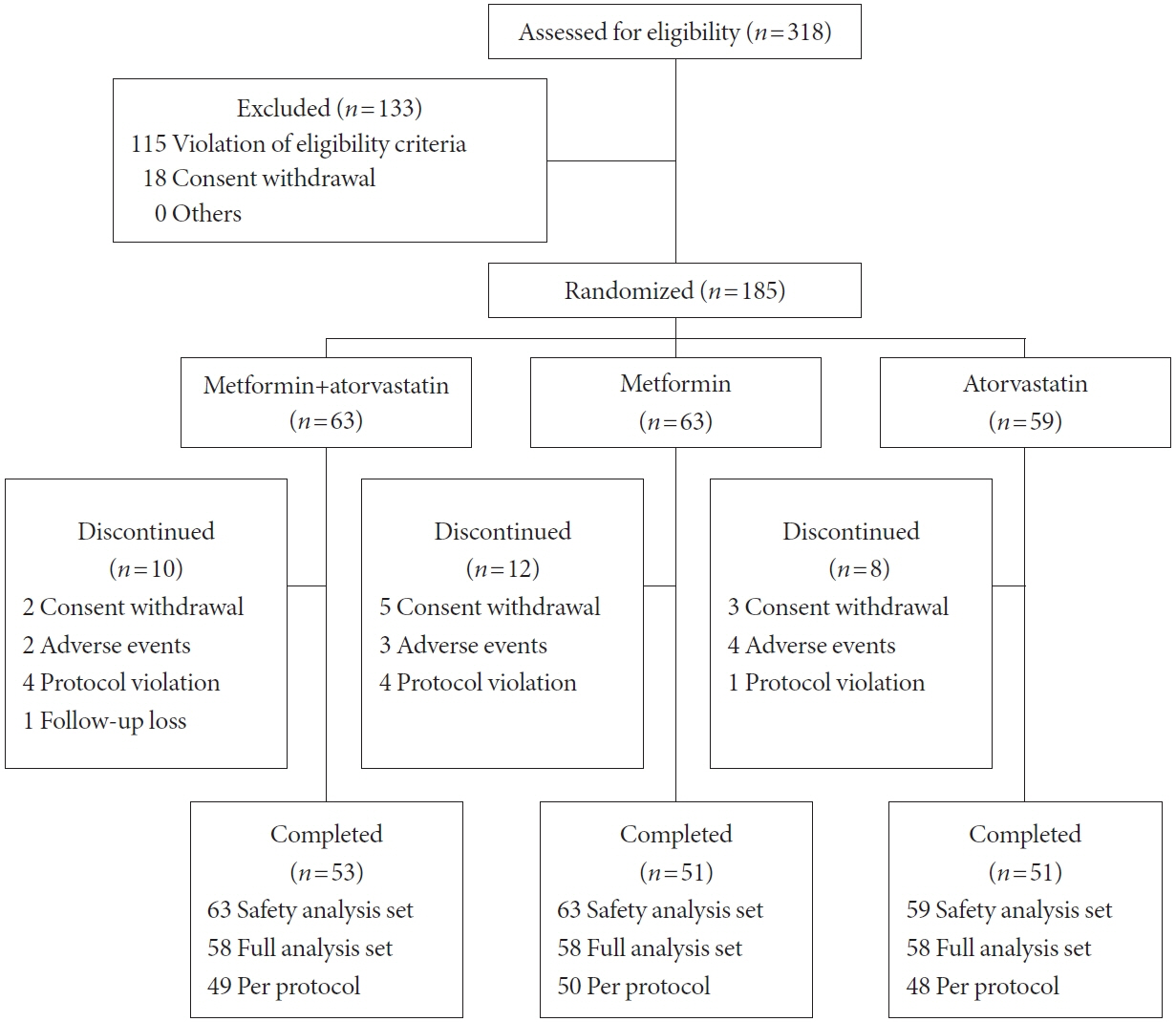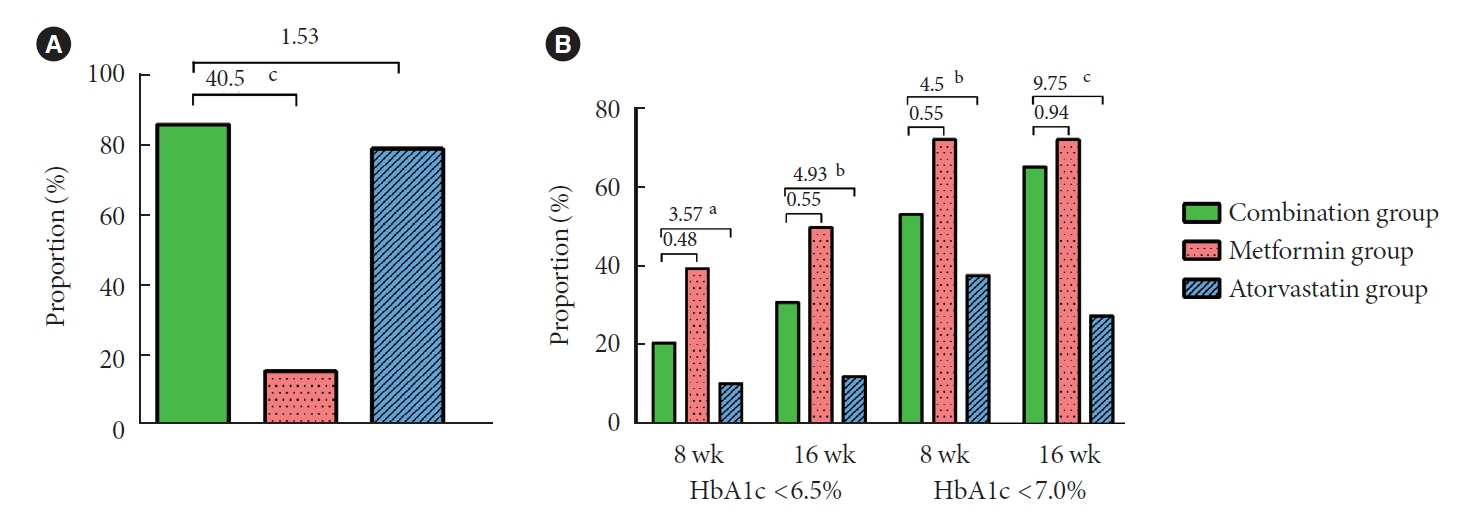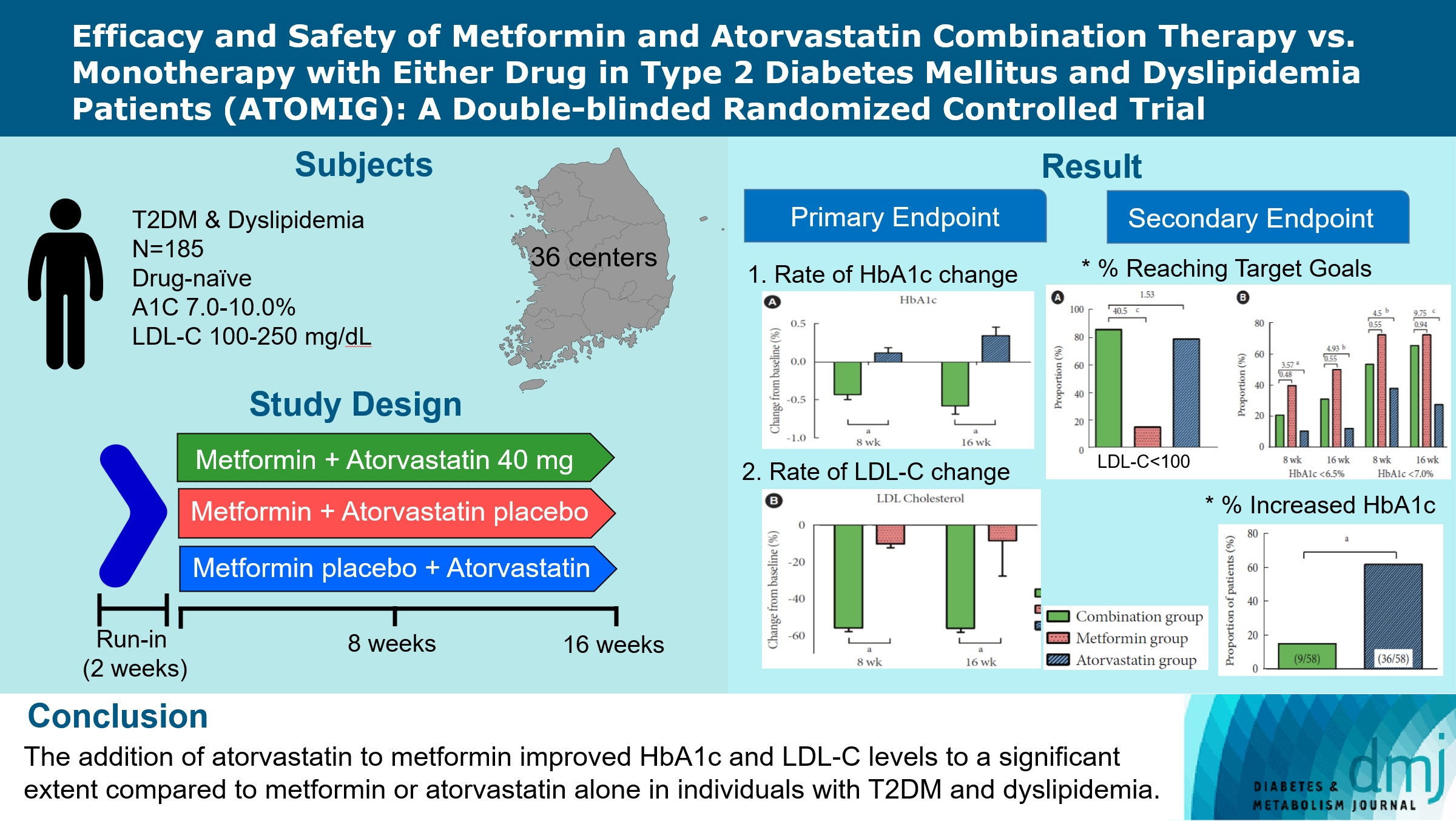Diabetes Metab J.
2024 Jul;48(4):730-739. 10.4093/dmj.2023.0077.
Efficacy and Safety of Metformin and Atorvastatin Combination Therapy vs. Monotherapy with Either Drug in Type 2 Diabetes Mellitus and Dyslipidemia Patients (ATOMIC): Double-Blinded Randomized Controlled Trial
- Affiliations
-
- 1Division of Endocrinology and Metabolism, Department of Internal Medicine, Uijeongbu Eulji Medical Center, Eulji University School of Medicine, Uijeongbu, Korea
- 2Division of Endocrinology and Metabolism, Department of Internal Medicine, Soonchunhyang University Gumi Hospital, Soonchunhyang University College of Medicine, Gumi, Korea
- 3Division of Endocrinology and Metabolism, Department of Internal Medicine, Bucheon St. Mary’s Hospital, College of Medicine, The Catholic University of Korea, Bucheon, Korea
- 4Department of Endocrinology and Metabolism, Kyung Hee University Hospital at Gangdong, College of Medicine, Kyung Hee University, Seoul, Korea
- 5Division of Endocrinology and Metabolism, Department of Internal Medicine, Konkuk University Medical Center, Seoul, Korea
- 6Division of Endocrinology and Metabolism, Department of Internal Medicine, Kyungpook National University Hospital, School of Medicine, Kyungpook National University, Daegu, Korea
- 7Division of Endocrinology and Metabolism, Department of Internal Medicine, Daegu Catholic University Medical Center, Daegu, Korea
- 8Division of Endocrinology and Metabolism, Department of Internal Medicine, Pusan National University Hospital, Busan, Korea
- 9Division of Endocrinology and Metabolism, Department of Internal Medicine, Seoul National University Bundang Hospital, Seoul National University College of Medicine, Seongnam, Korea
- 10Division of Endocrinology and Metabolism, Department of Internal Medicine, Kangdong Sacred Heart Hospital, College of Medicine, Hallym University, Seoul, Korea
- 11Division of Endocrinology and Metabolism, Department of Internal Medicine, Wonju Severance Christian Hospital, Yonsei University Wonju College of Medicine, Wonju, Korea
- 12Division of Endocrinology and Metabolism, Department of Internal Medicine, Kangbuk Samsung Hospital, Sungkyunkwan University School of Medicine, Seoul, Korea
- 13Division of Endocrinology and Metabolism, Department of Internal Medicine, Inje University Busan Paik Hospital, Busan, Korea
- 14Division of Endocrinology and Metabolism, Department of Internal Medicine, Inje University Ilsan Paik Hospital, Goyang, Korea
- 15Division of Endocrinology and Metabolism, Department of Internal Medicine, Changwon Fatima Hospital, Changwon, Korea
- 16Division of Endocrinology and Metabolism, Department of Internal Medicine, Asan Medical Center, University of Ulsan College of Medicine, Seoul, Korea
- 17Division of Endocrinology and Metabolism, Department of Internal Medicine, Chungbuk National University Hospital, Chungbuk National University College of Medicine, Cheongju, Korea
- 18Division of Endocrinology and Metabolism, Department of Internal Medicine, Seoul St. Mary’s Hospital, College of Medicine, The Catholic University of Korea, Seoul, Korea
- 19Division of Endocrinology and Metabolism, Department of Internal Medicine, Konyang University Hospital, Daejeon, Korea
- 20Department of Endocrinology and Metabolism, Kyung Hee University Hospital, College of Medicine, Kyung Hee University, Seoul, Korea
- 21Division of Endocrinology and Metabolism, Department of Internal Medicine, Korea University Anam Hospital, Korea University College of Medicine, Seoul, Korea
- 22Division of Endocrinology and Metabolism, Department of Internal Medicine, Gwangmyeong Sungae Hospital, Gwangmyeong, Korea
- 23Division of Endocrinology and Metabolism, Department of Internal Medicine, Ajou University Hospital, Ajou University School of Medicine, Suwon, Korea
- 24Division of Cardiology, Department of Internal Medicine, Gachon University Gil Medical Center, Gachon University College of Medicine, Incheon, Korea
- 25Division of Endocrinology and Metabolism, Department of Internal Medicine, Jeju National University School of Medicine, Jeju, Korea
- 26Division of Endocrinology and Metabolism, Department of Internal Medicine, Bundang Jesaeng Hospital, Seongnam, Korea
- 27Division of Endocrinology and Metabolism, Department of Internal Medicine, CHA Bundang Medical Center, CHA University School of Medicine, Seongnam, Korea
- 28Division of Endocrinology and Metabolism, Department of Internal Medicine, Korea University Ansan Hospital, Korea University College of Medicine, Ansan, Korea
- 29Division of Endocrinology and Metabolism, Department of Internal Medicine, Ulsan University Hospital, University of Ulsan College of Medicine, Ulsan, Korea
- 30Division of Endocrinology and Metabolism, Department of Internal Medicine, Busan St. Mary’s Hospital, Busan, Korea
- 31Division of Endocrinology and Metabolism, Department of Internal Medicine, Dong-A University Hospital, Dong-A University College of Medicine, Busan, Korea
- 32Division of Endocrinology and Metabolism, Department of Internal Medicine, Kangwon National University Hospital, Kangwon National University School of Medicine, Chuncheon, Korea
- 33Division of Endocrinology and Metabolism, Department of Internal Medicine, Wonkwang University Hospital, Wonkwang University School of Medicine, Iksan, Korea
- 34Division of Endocrinology and Metabolism, Department of Internal Medicine, Sungae Hospital, Seoul, Korea
- 35Division of Cardiology, Department of Internal Medicine, Soonchunhyang University Cheonan Hospital, Soonchunhyang University College of Medicine, Cheonan, Korea
- 36Division of Endocrinology and Metabolism, Department of Internal Medicine, Hallym University Kangnam Sacred Heart Hospital, College of Medicine, Hallym University, Seoul, Korea
- 37Division of Endocrinology and Metabolism, Department of Internal Medicine, Nowon Eulji Medical Center, Eulji University School of Medicine, Seoul, Korea
- KMID: 2558040
- DOI: http://doi.org/10.4093/dmj.2023.0077
Abstract
- Background
It is well known that a large number of patients with diabetes also have dyslipidemia, which significantly increases the risk of cardiovascular disease (CVD). This study aimed to evaluate the efficacy and safety of combination drugs consisting of metformin and atorvastatin, widely used as therapeutic agents for diabetes and dyslipidemia.
Methods
This randomized, double-blind, placebo-controlled, parallel-group and phase III multicenter study included adults with glycosylated hemoglobin (HbA1c) levels >7.0% and <10.0%, low-density lipoprotein cholesterol (LDL-C) >100 and <250 mg/dL. One hundred eighty-five eligible subjects were randomized to the combination group (metformin+atorvastatin), metformin group (metformin+atorvastatin placebo), and atorvastatin group (atorvastatin+metformin placebo). The primary efficacy endpoints were the percent changes in HbA1c and LDL-C levels from baseline at the end of the treatment.
Results
After 16 weeks of treatment compared to baseline, HbA1c showed a significant difference of 0.94% compared to the atorvastatin group in the combination group (0.35% vs. −0.58%, respectively; P<0.0001), whereas the proportion of patients with increased HbA1c was also 62% and 15%, respectively, showing a significant difference (P<0.001). The combination group also showed a significant decrease in LDL-C levels compared to the metformin group (−55.20% vs. −7.69%, P<0.001) without previously unknown adverse drug events.
Conclusion
The addition of atorvastatin to metformin improved HbA1c and LDL-C levels to a significant extent compared to metformin or atorvastatin alone in diabetes and dyslipidemia patients. This study also suggested metformin’s preventive effect on the glucose-elevating potential of atorvastatin in patients with type 2 diabetes mellitus and dyslipidemia, insufficiently controlled with exercise and diet. Metformin and atorvastatin combination might be an effective treatment in reducing the CVD risk in patients with both diabetes and dyslipidemia because of its lowering effect on LDL-C and glucose.
Keyword
Figure
Reference
-
1. Lin X, Xu Y, Pan X, Xu J, Ding Y, Sun X, et al. Global, regional, and national burden and trend of diabetes in 195 countries and territories: an analysis from 1990 to 2025. Sci Rep. 2020; 10:14790.
Article2. Saeedi P, Petersohn I, Salpea P, Malanda B, Karuranga S, Unwin N, et al. Global and regional diabetes prevalence estimates for 2019 and projections for 2030 and 2045: results from the International Diabetes Federation Diabetes Atlas, 9th edition. Diabetes Res Clin Pract. 2019; 157:107843.
Article3. Shaw JE, Sicree RA, Zimmet PZ. Global estimates of the prevalence of diabetes for 2010 and 2030. Diabetes Res Clin Pract. 2010; 87:4–14.
Article4. Eliasson B, Cederholm J, Eeg-Olofsson K, Svensson AM, Zethelius B, Gudbjornsdottir S, et al. Clinical usefulness of different lipid measures for prediction of coronary heart disease in type 2 diabetes: a report from the Swedish National Diabetes Register. Diabetes Care. 2011; 34:2095–100.5. McEwen LN, Karter AJ, Waitzfelder BE, Crosson JC, Marrero DG, Mangione CM, et al. Predictors of mortality over 8 years in type 2 diabetic patients: Translating Research Into Action for Diabetes (TRIAD). Diabetes Care. 2012; 35:1301–9.6. Lee JE, Min SH, Lee DH, Oh TJ, Kim KM, Moon JH, et al. Comprehensive assessment of lipoprotein subfraction profiles according to glucose metabolism status, and association with insulin resistance in subjects with early-stage impaired glucose metabolism. Int J Cardiol. 2016; 225:327–31.
Article7. Tenenbaum A, Fisman EZ, Motro M, Adler Y. Atherogenic dyslipidemia in metabolic syndrome and type 2 diabetes: therapeutic options beyond statins. Cardiovasc Diabetol. 2006; 5:20.
Article8. Naito R, Miyauchi K, Daida H. Racial differences in the cholesterol-lowering effect of statin. J Atheroscler Thromb. 2017; 24:19–25.
Article9. Jung CH, Son JW, Kang S, Kim WJ, Kim HS, Kim HS, et al. Diabetes fact sheets in Korea, 2020: an appraisal of current status. Diabetes Metab J. 2021; 45:1–10.10. Xu T, Brandmaier S, Messias AC, Herder C, Draisma HH, Demirkan A, et al. Effects of metformin on metabolite profiles and LDL cholesterol in patients with type 2 diabetes. Diabetes Care. 2015; 38:1858–67.11. Bailey CJ, Wilcock C, Scarpello JH. Metformin and the intestine. Diabetologia. 2008; 51:1552–3.
Article12. Jeppesen J, Zhou MY, Chen YD, Reaven GM. Effect of metformin on postprandial lipemia in patients with fairly to poorly controlled NIDDM. Diabetes Care. 1994; 17:1093–9.
Article13. Duca FA, Cote CD, Rasmussen BA, Zadeh-Tahmasebi M, Rutter GA, Filippi BM, et al. Metformin activates a duodenal AMPKdependent pathway to lower hepatic glucose production in rats. Nat Med. 2015; 21:506–11.
Article14. Erqou S, Lee CC, Adler AI. Statins and glycaemic control in individuals with diabetes: a systematic review and meta-analysis. Diabetologia. 2014; 57:2444–52.15. Cholesterol Treatment Trialists’ (CTT) Collaboration; Baigent C, Blackwell L, Emberson J, Holland LE, Reith C, et al. Efficacy and safety of more intensive lowering of LDL cholesterol: a meta-analysis of data from 170,000 participants in 26 randomised trials. Lancet. 2010; 376:1670–81.
Article16. Bae JC, Min KW, Kim YH, Kim KA, Hong EG, Park CY, et al. Efficacy and safety of fixed-dose combination therapy with gemigliptin (50 mg) and rosuvastatin compared with monotherapy in patients with type 2 diabetes and dyslipidaemia (BALANCE): a multicentre, randomized, double-blind, controlled, phase 3 trial. Diabetes Obes Metab. 2019; 21:103–11.
Article17. Ogawa H, Matsui K, Saito Y, Sugiyama S, Jinnouchi H, Sugawara M, et al. Differences between rosuvastatin and atorvastatin in lipid-lowering action and effect on glucose metabolism in Japanese hypercholesterolemic patients with concurrent diabetes: lipid-lowering with highly potent statins in hyperlipidemia with type 2 diabetes patients (LISTEN) study. Circ J. 2014; 78:2512–5.
Article18. Nascimbeni F, Aron-Wisnewsky J, Pais R, Tordjman J, Poitou C, Charlotte F, et al. Statins, antidiabetic medications and liver histology in patients with diabetes with non-alcoholic fatty liver disease. BMJ Open Gastroenterol. 2016; 3:e000075.
Article19. Sun J, Yuan Y, Cai R, Sun H, Zhou Y, Wang P, et al. An investigation into the therapeutic effects of statins with metformin on polycystic ovary syndrome: a meta-analysis of randomised controlled trials. BMJ Open. 2015; 5:e007280.20. Chung YR, Park SW, Choi SY, Kim SW, Moon KY, Kim JH, et al. Association of statin use and hypertriglyceridemia with diabetic macular edema in patients with type 2 diabetes and diabetic retinopathy. Cardiovasc Diabetol. 2017; 16:4.
Article
- Full Text Links
- Actions
-
Cited
- CITED
-
- Close
- Share
- Similar articles
-
- Letter: Efficacy and Safety of Voglibose Plus Metformin in Patients with Type 2 Diabetes Mellitus: A Randomized Controlled Trial (Diabetes Metab J 2019;43;276-86)
- Efficacy and Safety of Alogliptin-Pioglitazone Combination for Type 2 Diabetes Mellitus Poorly Controlled with Metformin: A Multicenter, Double-Blind Randomized Trial
- Response: Efficacy and Safety of Voglibose Plus Metformin in Patients with Type 2 Diabetes Mellitus: A Randomized Controlled Trial (Diabetes metab J 2019;43;276-86)
- A Review on Efficacy and Safety of SGLT2 Inhibitors as Add-on Therapy with Metformin
- Monotherapy in Type 2 Diabetes Mellitus Patients 2017: A Position Statement of the Korean Diabetes Association







